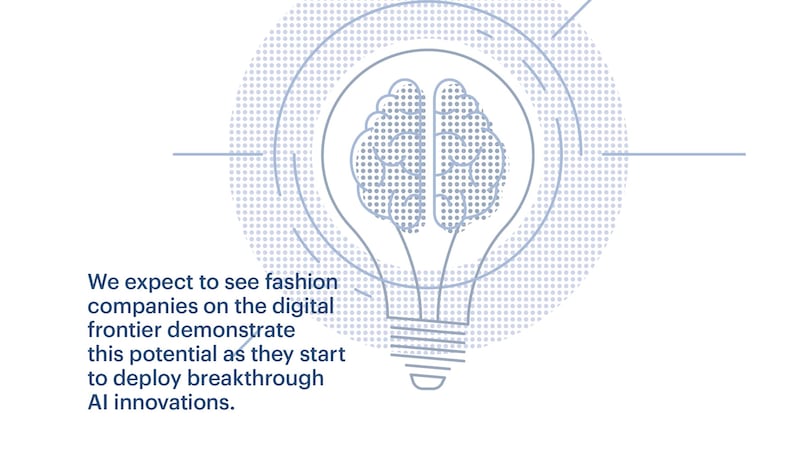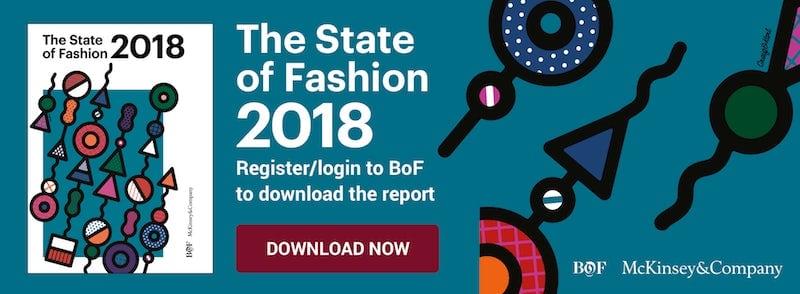
The Business of Fashion
Agenda-setting intelligence, analysis and advice for the global fashion community.

Agenda-setting intelligence, analysis and advice for the global fashion community.

The author has shared a YouTube video.
You will need to accept and consent to the use of cookies and similar technologies by our third-party partners (including: YouTube, Instagram or Twitter), in order to view embedded content in this article and others you may visit in future.
LONDON, United Kingdom — In our view, 2018 will be the year leading innovators begin to reveal — and revel in — the possibilities offered by Artificial Intelligence (AI) across all parts of the fashion value chain. Over the past couple of years, the potential of AI — computer systems able to perform tasks normally requiring human intelligence — has expanded considerably as a result of increasingly large and diverse data sets, advancement in key algorithms, and unprecedented levels of mathematical computing power. Although fashion has not thus far been a leader in this sphere, we expect to see fashion companies on the digital frontier demonstrate this potential as they start to deploy breakthrough AI innovations. Pioneers in this field will realise palpable returns from these efforts and demonstrate the potential advantages for companies that successfully marry creativity and AI.
Many fashion executives regard AI as too mechanical to capture the creative core of fashion, and so are uncertain of what exactly it can do for them. But AI’s benefits extend across the full fashion value chain. In fact, 20 percent of executives who took part in the BoF-McKinsey Global Fashion Survey believe that the use of AI to reinvent design, merchandising and marketing will be an important trend. AI can deliver significant speed, cost and flexibility improvements across the fashion supply chain. Consumers will enjoy the benefits of such improvements through better product availability and faster, more accurate deliveries. We are likely to see AI innovations ranging from predictive forecasting, capacity planning, and merchandising to automated production and delivery.

Stitch Fix offers a data-driven personal styling service | Source: Courtesy
But the potential of AI for the fashion industry goes beyond supply chain processes and automation, as it transcends typical machine tasks and blurs the lines between creativity and technology. Leading fashion companies will use it to enhance the creative process, design and product development; they will, for example, use algorithms to sift vast amounts of data to predict which product features customers are most likely to prefer. Amazon is on the verge of creating the first AI designer, with the development of an algorithm that designs clothes by analysing images, copying popular styles and using them to build completely new designs. Indian designer duo Falguni and Shane Peacock are using IBM’s cognitive tool Watson to map the future of Bollywood fashion by combining analyses of over 600,000 images of fashion runway shows and Indian couture. Likewise, fashion startup Stitch Fix deploys algorithms, rather than mood boards, to start creative processes and new designs; it uses algorithms that go through 30 million combinations of, for example blouse attributes, to predict which attributes customers will prefer, and eventually narrows down to just a few suggestions. Such examples highlight AI’s potential for identifying unmet customer needs and trends.
ADVERTISEMENT
In 2018 we expect to see more examples of how companies can deploy AI to redefine interactions and engagement with their customers. Customer relationship management is one of the next frontiers for AI, with early adopters focusing on improving customer insights through enriched data, opportunity stage recommendations, and dynamic pricing capabilities. In the online world, companies including Burberry and Tommy Hilfiger use chatbots, which enable 24/7 engagement with customers. AI can help improve offline engagement as well. Companies can, for example, use it to evaluate sensor-collected data and improve in-store experiences for target customers.
One good example is Farfetch’s “Store of the Future.” Automatic customer recognition at the store’s entrance, RFID-enabled clothing racks and digital mirrors that allow customers to choose sizes, colours and directly check out, all demonstrate how AI can be employed to excite customers in-store while seamlessly integrating the online and offline experiences.
AI-driven innovation may further expand the income gap between high-performing firms and their competitors.
AI can not only deliver competitive advantages to early adopters; it has the potential to disrupt the fashion industry entirely. Research on early adopters suggests that AI-driven innovation will be a new source of productivity and may further expand the income gap between high-performing firms and their competitors. Demand projection is a particularly interesting area due to the trend-driven nature of fashion. An AI-based approach for demand projection could reduce forecasting errors by up to 50 percent, while overall inventory reductions of 20 to 50 percent are feasible. To turn AI into a source of competitive advantage, fashion players should develop a compelling AI strategy. There is a broad array of possible use cases and technologies, often requiring different capabilities. Fashion companies need to focus on the areas that deliver most value and best support their business strategy.
At the same time, fashion has always been a collaborative industry — where would designers be without their petites mains? Similarly, as AI redefines the types of work best performed by humans alone and where AI can support work processes, questions emerge about the outlook for people employed in the fashion industry — where will jobs be lost, and where will they be enhanced? While this is not the first time that there has been anxiety about technology replacing jobs, the speed at which developments are taking place is unprecedented. Research suggests that approximately 20 to 30 percent of current jobs performed by fashion designers could be automated. At the same time, there will be many jobs that will be supplemented by, rather than replaced by, robots and machines, and AI will also create brand-new jobs. Fashion companies must consider the implications for their employees and their needs for reskilling if they want to foster a positive transition.
This article first appeared in The State of Fashion 2018, BoF and McKinsey & Company's in-depth report on the global fashion industry. Download it here.

Successful social media acquisitions require keeping both talent and technology in place. Neither is likely to happen in a deal for the Chinese app, writes Dave Lee.
TikTok’s first time sponsoring the glitzy event comes just as the US effectively deemed the company a national security threat under its current ownership, raising complications for Condé Nast and the gala’s other organisers.
BoF Careers provides essential sector insights for fashion's technology and e-commerce professionals this month, to help you decode fashion’s commercial and creative landscape.
The algorithms TikTok relies on for its operations are deemed core to ByteDance overall operations, which would make a sale of the app with algorithms highly unlikely.